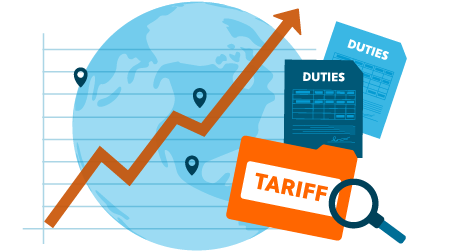
How to handle US-China tariffs and the end of de minimis
Last updated on April 23, 2025, at 7:15 p.m. ET. Attend our webinar series, Trade and Tariff Tuesdays, to hear Avalara experts discuss global trade issues and their business implications.
The trade war between China and the United States is escalating. With tariff policies changing by the week, and sometimes by the hour, it’s a volatile time for the international trade community.
Here’s what you need to know.
What are the China tariffs?
As of April 9, 2025, products of China and Hong Kong are subject to a 125% reciprocal tariff, a 20% tariff to address the threat of illicit drugs, and the Section 301 tariffs implemented prior to 2025, which range from 7.5% and 100%.
For select products, the total tariff is 245%. However, on April 22, President Donald J. Trump indicated that he’ll lower the 145% punitive tariff “substantially.” Details have yet to be announced.
10% tariff implemented February 4
The U.S. imposed a 10% tariff on China starting at 12:01 a.m. ET on February 4, 2025. This 10% tariff is on top of the existing Section 301 tariffs on Chinese imports and applies to products of Hong Kong as well.
The executive order didn’t provide for drawback, and there was no stated exclusion process.
20% tariff implemented March 4
On March 3, President Trump doubled the 10% China tariff. The 20% tariff applies to products of China and Hong Kong entered for consumption, or withdrawn from warehouse for consumption, on or after 12:01 a.m. ET on March 4, 2025.
Reciprocal tariffs implemented April 9, then increased
On April 2, President Trump said the U.S. would impose an additional 34% reciprocal tariff on China starting April 9, 2025, at 12:01 a.m. ET. The 34% included the new baseline 10% tariff that applies to all countries as of April 5.
On April 8, after China announced retaliatory tariffs on U.S. imports, the U.S. increased the 34% tariff to 84%. The 84% duty took effect at 12:01 a.m. ET on April 9.
Then, on April 9, Trump said he was raising the tariff on China to 125%, effective immediately. Per his executive order, the 125% replaces the 84% previously announced and also applies to products of Hong Kong and Macau. The 125% tariff took effect at 12:01 a.m. on April 10.
China responded by increasing tariffs on U.S. goods from 84% to 125%.
As the tariffs are stackable, products of China are subject to the following:
Section 301 tariffs implemented prior to February 1, 2025 (various rates ranging from 7.5% to 100%)
20% tariff implemented March 4, 2025
125% reciprocal tariff as of April 10, 2025
The grand total for most products of China is more than 145%. A White House fact sheet dated April 15, 2025, notes that “China faces up to a 245% tariff on imports to the United States.” The 245% tariff applies to electric vehicles and syringes.
There are some exclusions. Goods not subject to the reciprocal tariff include:
- Articles subject to 50 USC 1702(b)
- Bullion
- Copper, pharmaceuticals, semiconductors, and lumber articles
- Energy and certain minerals that are not available in the United States
- Steel/aluminum articles and autos/auto parts already subject to Section 232 tariffs, and all articles that may be subject to future Section 232 tariffs
Drawback is available with respect to the reciprocal tariffs. U.S. Customs and Border Protection (CBP) is publishing updated guidance as it can.
Smartphones and other products exempted from reciprocal tariffs
On April 11, the White House announced exceptions to the reciprocal tariffs on China. Affected products include electronics such as computers, semiconductors, and smartphones.
Updated guidance from CBP states that the 125% reciprocal tariffs do not apply to select merchandise entered for consumption, or withdrawn from warehouse for consumption, on or after 12:01 a.m. ET on April 5, 2025. Importers may request a refund of duty paid before this exclusion was provided.
The guidance from the CBP and the White House includes a list of Harmonized Tariff Schedule of the United States (HTSUS) codes for the affected products. The 20% tariff implemented March 4 continues to apply to these products.
What’s changing with de minimis imports from China?
The United States is eliminating de minimis for China and Hong Kong starting May 2, 2025. The Secretary of Commerce was said to be considering whether to extend these rules to packages from Macau. However, CBP guidance published on April 18 doesn’t reference Macau.
The de minimis exemption provided by 19 U.S. C. § 1321(a)(2)(C) (aka Section 321 shipments) allows one shipment of goods (per person, per day) valued at or under $800 to enter the U.S. free from duty and import taxes. This will remain in effect for other countries, as far as we know now.
But CBP will reject requests for de minimis entry and clearance for ineligible shipments of products of China and Hong Kong.
New duty and postal fees for de minimis imports arriving by international mail
Goods from China and Hong Kong valued at or under $800 are subject to an ad valorem rate of duty or a postal fee starting May 2, 2025, at 12:01 a.m. ET.
The duty was initially set at 30% of the value of the postal item, but on April 8, the duty was increased to 90% of the value of the postal item. On April 9, President Trump increased the de minimis duty to 120%.
The per postal item containing goods duty for low-value postal shipments is $100 starting May 2. This fee will increase to $200 at 12:01 a.m. ET on June 1, 2025.
The postal fees were initially set at $25 starting May 2, and $50 starting June 1, but the White House raised the postal fees in executive orders dated April 8 and April 9.
De minimis eliminated for other international shipments
A White House fact sheet dated April 2 eliminated the de minimis exemption for Chinese goods sent through means other than the international postal network. It extended all applicable duties to de minimis goods from China starting May 2 at 12:01 a.m. ET.
The April 8 and April 9 executive orders increased rates of duty for China as described above.
De minimis policy in flux since February 1
President Trump initially eliminated the de minimis provision for China and Hong Kong effective February 4. Yet since he announced the policy change on February 1, and allowed no grace period for low-value shipments in transit, customs officials were overwhelmed. The United States Postal Service (USPS) temporarily stopped accepting inbound packages from China. Businesses scrambled to comply.
Trump reinstated de minimis for China and Hong Kong on February 5 to give the Secretary of Commerce and CBP time to implement “adequate systems ... to fully and expediently process and collect tariff revenue.”
As of April 9, 2025, de minimis policies for China and Hong Kong are set to change on May 2.
For now, the U.S. will continue to accept duty-free low-value imports from most other countries. Yet President Trump and Congress are looking to change the de minimis policy eventually.
How to import low-value products from China given the Trump tariff changes
Effective May 2, 2025, a new import process will be required for shipments of products of China and Hong Kong, including postal shipments. Entry Type 86 will no longer be accepted for low-value imports from China and Hong Kong.
Merchandise subject to the president’s executive orders on de minimis may not be entered by submitting any paper entry forms or documents. Other than for mail, entries must be made in ACE.
This will increase costs and shipping times. Filers and importers will need to:
- File the appropriate formal or informal entry
- Pay all applicable duties, taxes, and fees
Formal entry (Entry Type 1) is required for shipments with a value greater than $2,500.
Informal entry (Entry Type 11) will likely be the best option for most low-value shipments from China and Hong Kong once de minimis is eliminated. It will also be appropriate for certain low-risk goods (e.g., products exempt from quotas or countervailing duties).
Requirements for informal entry (Entry Type 11)
Entry Type 11 is an informal entry process, but it’s still more burdensome than the process many businesses may currently use for de minimis shipments.
The main requirement with Entry Type 11 is the completion of CBP Form 7501, which must be filed electronically through the CBP Automated Commercial Environment (ACE) system.
“Completing the form is an additional administrative step that many will find burdensome,” says Patrick Frith, Senior Director of Growth Cross-Border at Avalara.
Information requirements for Entry Type 11
The key information required for CBP Form 7501 includes:
- Importer and entry information
- Shipment and transport details
- Merchandise and classification, including the 10-digit Harmonized Tariff Schedule (HTS) code for each item
- Valuation and duty calculation (transaction value is based on the price paid for the merchandise when sold for export to the U.S., plus any applicable packing costs, selling commission, royalty fees, etc.)
- Additional declarations and certifications
Estimated duties must be deposited within 10 days of the release of the merchandise.
Challenges of using Entry Type 11
Determining the proper 10-digit HTS code is one of the most challenging tasks for businesses shipping goods internationally. But it’s essential: If ecommerce sellers, online marketplaces, importers, shippers, or others responsible for filing the informal entry use the wrong code, the incorrect duty may be applied. This can result in additional delays at customs and/or penalties and fines.
Businesses that have benefited from the de minimis exemption may not be accustomed to classifying products with 10-digit HTS codes. Their systems may not be set up to apply tariffs for these shipments.
How can businesses comply with the de minimis rule changes?
“From a trade compliance standpoint, the landscape has become incredibly complex,” says Shane Bogdan, Director of Cross-Border Sales at Avalara. “China now faces standard commodity duty rates, Section 301 tariffs, the newly implemented 20% blanket duty, and, on top of that, the reciprocal tariff. That’s at least four layers of tariffs to calculate and manage for every single shipment. Businesses are now in a constant state of reassessment and classification on these tariffs.”
The most effective way for businesses to meet the changing demands of tariff changes is to automate customs duty compliance.
Avalara Cross-Border delivers real-time calculation of customs duties and import taxes and automates the assignment of the full 10-digit HTS codes required under Entry Type 11.
Our customers are benefitting from our technology. “Avalara’s suite of compliance services can help you stay on top of this rapidly changing environment, giving you peace of mind that you are keeping pace with the changes,” says Craig Reed, General Manager of Cross-Border at Avalara.
More tariff changes are likely, and finding accurate, up-to-date information can be difficult. Whatever happens, let us help you stay ahead of change and continue to grow globally. Contact us today to learn more.
FAQ
What is the de minimis exemption?
The de minimis provision allows many goods valued at or under $800 to enter the U.S. duty free and via an expedited entry process known as Entry Type 86. The $800 de minimis threshold is per person per day.
Many countries offer de minimis exemptions, but most use a threshold lower than $800. It used to be lower in the U.S. too: Congress raised the de minimis threshold from $200 to $800 in 2016, opening the floodgates for low-value shipments.
Why is the U.S. getting rid of de minimis?
U.S. Customs and Border Protection (CBP) processed more than 1.36 billion de minimis shipments in fiscal year 2024. For this reason, and because bad actors have been exploiting de minimis to smuggle illegal goods into the country, the U.S. is looking to change its de minimis policy.
CBP proposed new rules to limit the duty exemption for low-value shipments on January 17, 2025. One option on the table is to eliminate the de minimis exemption for imports sold through an online marketplace. We’re waiting to see what happens next.
What is Entry Type 86?
Entry Type 86 is a customs entry process that requires the importer of record to file the necessary import documents electronically with U.S. Customs and Border Protection (CBP) through the agency’s Automated Commercial Environment (ACE) portal.
Harmonized Tariff Schedule (HTS) codes are required for low-value shipments imported into the U.S. under Entry Type 86.
What are HTS codes?
The Harmonized System (HS) is a global product classification system used throughout import and export processes. The World Customs Organization (WCO) updates the HS every five years. The next update is slated for 2027.
HS codes are the common six-digit import/export codes assigned to every product.
HTS codes are the extended 10-digit codes assigned to goods entering the U.S. HTS codes consist of the six-digit HS code plus an additional four-digit code unique to the U.S. They are sometimes called HTSUS codes (Harmonized Tariff Schedule of the United States).
HS, HTS, and HTSUS codes are linked to international tariffs. If you assign the wrong code to a product, you may end up assigning the wrong tariff rate. Watch a webinar about HS codes.
What’s China’s response to the U.S. tariffs?
China implemented the following retaliatory tariffs on February 10, 2025:
A 15% tariff on coal and liquified natural gas imports from the U.S.
Additional 10% duties on crude oil, agricultural machinery, and some cars and pickup trucks
In response to the U.S. retaliatory tariffs announced April 2, Beijing In response to the U.S. retaliatory tariffs announced April 2, Beijing said it would impose an additional 34% tariff on U.S. goods starting April 10. On April 9, China increased the 34% tariff to 84%. Following another U.S. tariff rate hike, China increased the retaliatory tariffs on American goods to 125% as of April 12, 2025.
China also placed export controls on certain rare-earth minerals to the U.S.
How are shipping companies responding to tariffs?
Shipping companies are increasing fees or suspending shipments in response to the United States’ new tariffs and the end of de minimis for products of China and Hong Kong. They’re also anticipating longer transit times.
DHL suspended the collection and shipping of business-to-consumer shipments to private individuals in the U.S. on April 21, for products with a declared customs value of more than $800. This suspension doesn’t apply to business-to-business shipments valued above $800. However, B2B shipments may also experience delays.
Additionally, all DHL shipments to the U.S. valued more than $800 require formal entry processing as of April 5; the previous threshold was $2,500.
FedEx is adjusting demand surcharges for U.S. imports. Between April 15 and May 2, there’s a $0.45-per-pound charge for imports from China, Hong Kong, and the Philippines.
Effective May 2, 2025, FedEx is increasing both the disbursement fee (aka, advancement fee or duty handling fee) and the duty and tax forwarding fee for shipments with a customs value equal to or less than $800.
UPS implemented a $0.29-per-pound surge fee effective April 13 for all shipments to the U.S. originating from China, Hong Kong, and Macau. The shipper underscores that surge fees are subject to change.
Hongkong Post has also reacted to Trump’s tariff policies. On April 16, the government of Hong Kong issued a press release stating:
“Hongkong Post will definitely not collect any so-called tariffs on behalf of the U.S. and will suspend the acceptance of postal items containing goods destined to the U.S.”
“Hongkong Post will suspend the acceptance of surface postal items containing goods destined to the U.S. with immediate effect (April 16).”
“Hongkong Post will suspend the acceptance of air postal items containing goods destined to the U.S. starting from April 27.”
Avalara Cross-Border can help your business comply with cross-border duties and tariffs, no matter how often they change. Contact us to get started.
For more tariff news, read:
- What are tariffs? How do they work?
- Chips, drugs, and steel: How to prepare for Trump tariffs
- De minimis changes are coming: Is your business ready?
- What you need to know about the US-Canada trade war
- Trump steel and aluminum tariffs: What you need to know
- How new tariffs will impact the beverage alcohol industry

Simplify cross-border tariff compliance with automation
Stay ahead of changing trade regulations with automated tariff code classification and duty calculations
Stay up to date
Sign up for our free newsletter and stay up to date with the latest tax news.












